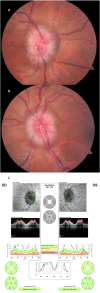Managing idiopathic intracranial hypertension in the eye clinic
- PMID: 38789788
- PMCID: PMC11306398
- DOI: 10.1038/s41433-024-03140-y
Managing idiopathic intracranial hypertension in the eye clinic
Abstract
Idiopathic intracranial hypertension (IIH) is a neuro-ophthalmological condition characterised by a raised intracranial pressure and papilloedema that causes disabling headaches. The main risk factors of female sex and living with obesity have been known for some time, however the knowledge of the underlying pathophysiology is evolving. Papilloedema can impact the visual function, and the majority of people are offered acetazolamide. Those with sight threatening disease need urgent management, though there is little high quality evidence to recommend any particular surgical intervention. Headache treatment is an unmet clinical need and simple medication overuse advice has the potential to reduce the chronification of migraine-like headaches. IIH is emerging as a systemic metabolic disease distinct from people living with obesity alone. While weight loss is the main stay of disease modifying therapy this is challenging to access and many healthcare professionals that manage the condition have no formal training or accessible pathways for weight management. The aim of this "how to do it" article is to present the latest advances in knowledge of IIH that we pragmatically included in routine clinical care for people living with the condition.
© 2024. The Author(s).
Conflict of interest statement
Susan Mollan has received payment for consultancy work from Invex Therapeutics. She has received payment for advisory boards from Gentech and Ocular Therapeutix. Grant funding has been paid to her institution from the National Institute of Health Research (NIHR131211), UK Space Agency and IIHUK. Authors declare no other financial relationships with any organisations that might have an interest in the submitted work; and no other relationships or activities that could appear to have influenced the submitted work.
Figures




References
Publication types
MeSH terms
Substances
LinkOut - more resources
Full Text Sources

